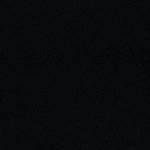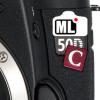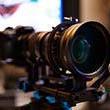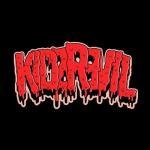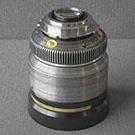
Brian Caldwell
-
Posts
153 -
Joined
-
Last visited
Reputation Activity
-
 Brian Caldwell got a reaction from andrgl in A Tale of Two T2.0 Zooms (for A6300)
Brian Caldwell got a reaction from andrgl in A Tale of Two T2.0 Zooms (for A6300)
The Fuji Premier 14.5-45mm T2.0 ( http://www.bhphotovideo.com/c/product/840519-REG/Fujinon_HK3_1X14_5_F_HK3_1X14_5F_14_5_45mm_T2_0_ZOOM.html ) is pretty well known in the professional cine world. But, if you've ever hefted one in person you know its not only priced like a small house (~$100k), its nearly the same size and weight as well! So, naturally, I'm curious to know how it might perform on the upcoming A6300 in comparison to something much cheaper. Like the Tamron 24-70mm/2.8 with a Speed Booster, which gives you a 17-50mm/2.0. Obviously, the latter is practically $free compared to the former, and you do give up the 14.5mm - 17mm range along with perhaps 1/4-1/3 stop difference in aperture due to f/# vs T/#. But, you gain autofocus, image stabilization, a little extra reach at the long end, and an unbelievably huge reduction in size/weight/cost. I would not be surprised in image quality is nearly equal.
-
 Brian Caldwell got a reaction from Andrew Reid in A Tale of Two T2.0 Zooms (for A6300)
Brian Caldwell got a reaction from Andrew Reid in A Tale of Two T2.0 Zooms (for A6300)
The Fuji Premier 14.5-45mm T2.0 ( http://www.bhphotovideo.com/c/product/840519-REG/Fujinon_HK3_1X14_5_F_HK3_1X14_5F_14_5_45mm_T2_0_ZOOM.html ) is pretty well known in the professional cine world. But, if you've ever hefted one in person you know its not only priced like a small house (~$100k), its nearly the same size and weight as well! So, naturally, I'm curious to know how it might perform on the upcoming A6300 in comparison to something much cheaper. Like the Tamron 24-70mm/2.8 with a Speed Booster, which gives you a 17-50mm/2.0. Obviously, the latter is practically $free compared to the former, and you do give up the 14.5mm - 17mm range along with perhaps 1/4-1/3 stop difference in aperture due to f/# vs T/#. But, you gain autofocus, image stabilization, a little extra reach at the long end, and an unbelievably huge reduction in size/weight/cost. I would not be surprised in image quality is nearly equal.
-
 Brian Caldwell got a reaction from Xavier Plagaro Mussard in A Tale of Two T2.0 Zooms (for A6300)
Brian Caldwell got a reaction from Xavier Plagaro Mussard in A Tale of Two T2.0 Zooms (for A6300)
The Fuji Premier 14.5-45mm T2.0 ( http://www.bhphotovideo.com/c/product/840519-REG/Fujinon_HK3_1X14_5_F_HK3_1X14_5F_14_5_45mm_T2_0_ZOOM.html ) is pretty well known in the professional cine world. But, if you've ever hefted one in person you know its not only priced like a small house (~$100k), its nearly the same size and weight as well! So, naturally, I'm curious to know how it might perform on the upcoming A6300 in comparison to something much cheaper. Like the Tamron 24-70mm/2.8 with a Speed Booster, which gives you a 17-50mm/2.0. Obviously, the latter is practically $free compared to the former, and you do give up the 14.5mm - 17mm range along with perhaps 1/4-1/3 stop difference in aperture due to f/# vs T/#. But, you gain autofocus, image stabilization, a little extra reach at the long end, and an unbelievably huge reduction in size/weight/cost. I would not be surprised in image quality is nearly equal.
-
 Brian Caldwell got a reaction from jcs in A Tale of Two T2.0 Zooms (for A6300)
Brian Caldwell got a reaction from jcs in A Tale of Two T2.0 Zooms (for A6300)
I'm not entirely sure about the IQ - its something I would want to test. Its worth noting that inexpensive stills glass is often better than very expensive cine glass. For example, I once did a projection bench comparison of an older generation Nikon 70-200mm f/2.8 zoom against a $20k Zeiss 80-200 T2.9 CZ.2, and the Nikon was clearly superior, especially in the corners. I suspect there is a good reason why you *never* see MTF charts of cine glass!
I haven't found a way to do it in a compact form factor while maintaining even remotely decent image quality. There is an infamous Kodak patent that addresses this problem, but the example given in the patent is so incredibly poor that its just not enabling at all. You could do it with a relay type system, which I would call a Keplerian style, or real image focal reducer. However, you then wind up with a huge ungainly and under-performing setup just like the old Nikon E3.
Its incredibly nice to learn about this (!!), and I'd like to know as much as possible about your work. BTW, a Speed Booster XL will take an f/2.8 zoom down to f/1.8, which is probably around T/2.0 for most zooms.
-
 Brian Caldwell got a reaction from Julian in A Tale of Two T2.0 Zooms (for A6300)
Brian Caldwell got a reaction from Julian in A Tale of Two T2.0 Zooms (for A6300)
The Fuji Premier 14.5-45mm T2.0 ( http://www.bhphotovideo.com/c/product/840519-REG/Fujinon_HK3_1X14_5_F_HK3_1X14_5F_14_5_45mm_T2_0_ZOOM.html ) is pretty well known in the professional cine world. But, if you've ever hefted one in person you know its not only priced like a small house (~$100k), its nearly the same size and weight as well! So, naturally, I'm curious to know how it might perform on the upcoming A6300 in comparison to something much cheaper. Like the Tamron 24-70mm/2.8 with a Speed Booster, which gives you a 17-50mm/2.0. Obviously, the latter is practically $free compared to the former, and you do give up the 14.5mm - 17mm range along with perhaps 1/4-1/3 stop difference in aperture due to f/# vs T/#. But, you gain autofocus, image stabilization, a little extra reach at the long end, and an unbelievably huge reduction in size/weight/cost. I would not be surprised in image quality is nearly equal.
-
 Brian Caldwell got a reaction from andy lee in A Tale of Two T2.0 Zooms (for A6300)
Brian Caldwell got a reaction from andy lee in A Tale of Two T2.0 Zooms (for A6300)
I'm not entirely sure about the IQ - its something I would want to test. Its worth noting that inexpensive stills glass is often better than very expensive cine glass. For example, I once did a projection bench comparison of an older generation Nikon 70-200mm f/2.8 zoom against a $20k Zeiss 80-200 T2.9 CZ.2, and the Nikon was clearly superior, especially in the corners. I suspect there is a good reason why you *never* see MTF charts of cine glass!
I haven't found a way to do it in a compact form factor while maintaining even remotely decent image quality. There is an infamous Kodak patent that addresses this problem, but the example given in the patent is so incredibly poor that its just not enabling at all. You could do it with a relay type system, which I would call a Keplerian style, or real image focal reducer. However, you then wind up with a huge ungainly and under-performing setup just like the old Nikon E3.
Its incredibly nice to learn about this (!!), and I'd like to know as much as possible about your work. BTW, a Speed Booster XL will take an f/2.8 zoom down to f/1.8, which is probably around T/2.0 for most zooms.
-
 Brian Caldwell got a reaction from andy lee in A Tale of Two T2.0 Zooms (for A6300)
Brian Caldwell got a reaction from andy lee in A Tale of Two T2.0 Zooms (for A6300)
The Fuji Premier 14.5-45mm T2.0 ( http://www.bhphotovideo.com/c/product/840519-REG/Fujinon_HK3_1X14_5_F_HK3_1X14_5F_14_5_45mm_T2_0_ZOOM.html ) is pretty well known in the professional cine world. But, if you've ever hefted one in person you know its not only priced like a small house (~$100k), its nearly the same size and weight as well! So, naturally, I'm curious to know how it might perform on the upcoming A6300 in comparison to something much cheaper. Like the Tamron 24-70mm/2.8 with a Speed Booster, which gives you a 17-50mm/2.0. Obviously, the latter is practically $free compared to the former, and you do give up the 14.5mm - 17mm range along with perhaps 1/4-1/3 stop difference in aperture due to f/# vs T/#. But, you gain autofocus, image stabilization, a little extra reach at the long end, and an unbelievably huge reduction in size/weight/cost. I would not be surprised in image quality is nearly equal.
-
 Brian Caldwell got a reaction from redimp in 1.79x Squeeze Anamorphic
Brian Caldwell got a reaction from redimp in 1.79x Squeeze Anamorphic
Thanks for your feedback on the squeeze ratio - I was definitely interested in what you would think.
I own Caldwell Photographic, and I design all the Speed Booster optics.
-
 Brian Caldwell got a reaction from Jonathan Lee in A Tale of Two T2.0 Zooms (for A6300)
Brian Caldwell got a reaction from Jonathan Lee in A Tale of Two T2.0 Zooms (for A6300)
The Fuji Premier 14.5-45mm T2.0 ( http://www.bhphotovideo.com/c/product/840519-REG/Fujinon_HK3_1X14_5_F_HK3_1X14_5F_14_5_45mm_T2_0_ZOOM.html ) is pretty well known in the professional cine world. But, if you've ever hefted one in person you know its not only priced like a small house (~$100k), its nearly the same size and weight as well! So, naturally, I'm curious to know how it might perform on the upcoming A6300 in comparison to something much cheaper. Like the Tamron 24-70mm/2.8 with a Speed Booster, which gives you a 17-50mm/2.0. Obviously, the latter is practically $free compared to the former, and you do give up the 14.5mm - 17mm range along with perhaps 1/4-1/3 stop difference in aperture due to f/# vs T/#. But, you gain autofocus, image stabilization, a little extra reach at the long end, and an unbelievably huge reduction in size/weight/cost. I would not be surprised in image quality is nearly equal.
-
 Brian Caldwell got a reaction from Caleb Genheimer in 1.79x Squeeze Anamorphic
Brian Caldwell got a reaction from Caleb Genheimer in 1.79x Squeeze Anamorphic
The responses here have been very thoughtful, and have given me much to consider. I may modify my product direction a bit, but on the whole, it seems that my ideas aren't entirely crazy.
-
 Brian Caldwell got a reaction from nahua in 1.79x Squeeze Anamorphic
Brian Caldwell got a reaction from nahua in 1.79x Squeeze Anamorphic
Thanks for your comments. I agree regarding the bokeh shape. In the case of my test shot the bokeh is actually nine-sided, which is created by the iris shape in the Nikon 135mm f/2 AiS Nikkor that I used as a spherical backer lens. Upcoming integrated primes will use a very circular iris to yield nice smooth elliptical bokeh.
-
 Brian Caldwell got a reaction from Julian in 1.79x Squeeze Anamorphic
Brian Caldwell got a reaction from Julian in 1.79x Squeeze Anamorphic
I've recently started numerous anamorphic lens projects based on the idea that 1.79x squeeze is the ideal ratio when dealing with a 4:3 sensor . It's often stated that 2x squeeze on 4:3 gives you the DCI standard 2.39:1 scope ratio, but of course this isn't quite true. If you really want a perfect mapping of 4:3 to 2.39:1 without having to crop the sides, then the correct math is: 2.39/(4/3) = 1.7925, which I'll round off to 1.79. So, for the ARRI Alexa, RED Dragon and Panasonic GH4 used in 4:3 mode it seems to me that 1.79x is ideal. Also, if you consider the Alexa in its Open Gate format (1.55:1) you get 1.55 * 1.79 = 2.77:1, which is almost exactly equal to the classic Ultra Panavision 70 (2.76:1 aspect ratio).
You might be concerned that 1.79x wouldn't give enough anamorphic artifacts, but based on my experience so far it seems that the artifacts are very similar to 2x, and in addition there are significant advantages in size, weight, cost, and image quality. Some time ago I built a 1.80x prototype that used very traditional rear-group focusing with counter-rotating astigmatizer aberration compensation, and found that it compared very favorably to a similar-spec 2x 140mm Hawk V-Lite:
So, my question is, since I'm about to start spending money like crazy developing this stuff, am I crazy to be going in this direction?
-
 Brian Caldwell got a reaction from nahua in 1.79x Squeeze Anamorphic
Brian Caldwell got a reaction from nahua in 1.79x Squeeze Anamorphic
Thanks for your feedback on the squeeze ratio - I was definitely interested in what you would think.
I own Caldwell Photographic, and I design all the Speed Booster optics.
-
 Brian Caldwell got a reaction from Xavier Plagaro Mussard in 1.79x Squeeze Anamorphic
Brian Caldwell got a reaction from Xavier Plagaro Mussard in 1.79x Squeeze Anamorphic
Thanks for your comments. I agree regarding the bokeh shape. In the case of my test shot the bokeh is actually nine-sided, which is created by the iris shape in the Nikon 135mm f/2 AiS Nikkor that I used as a spherical backer lens. Upcoming integrated primes will use a very circular iris to yield nice smooth elliptical bokeh.
-
 Brian Caldwell got a reaction from nahua in 1.79x Squeeze Anamorphic
Brian Caldwell got a reaction from nahua in 1.79x Squeeze Anamorphic
I've recently started numerous anamorphic lens projects based on the idea that 1.79x squeeze is the ideal ratio when dealing with a 4:3 sensor . It's often stated that 2x squeeze on 4:3 gives you the DCI standard 2.39:1 scope ratio, but of course this isn't quite true. If you really want a perfect mapping of 4:3 to 2.39:1 without having to crop the sides, then the correct math is: 2.39/(4/3) = 1.7925, which I'll round off to 1.79. So, for the ARRI Alexa, RED Dragon and Panasonic GH4 used in 4:3 mode it seems to me that 1.79x is ideal. Also, if you consider the Alexa in its Open Gate format (1.55:1) you get 1.55 * 1.79 = 2.77:1, which is almost exactly equal to the classic Ultra Panavision 70 (2.76:1 aspect ratio).
You might be concerned that 1.79x wouldn't give enough anamorphic artifacts, but based on my experience so far it seems that the artifacts are very similar to 2x, and in addition there are significant advantages in size, weight, cost, and image quality. Some time ago I built a 1.80x prototype that used very traditional rear-group focusing with counter-rotating astigmatizer aberration compensation, and found that it compared very favorably to a similar-spec 2x 140mm Hawk V-Lite:
So, my question is, since I'm about to start spending money like crazy developing this stuff, am I crazy to be going in this direction?
-
 Brian Caldwell got a reaction from Tito Ferradans in 1.79x Squeeze Anamorphic
Brian Caldwell got a reaction from Tito Ferradans in 1.79x Squeeze Anamorphic
Thanks for your comments. I agree regarding the bokeh shape. In the case of my test shot the bokeh is actually nine-sided, which is created by the iris shape in the Nikon 135mm f/2 AiS Nikkor that I used as a spherical backer lens. Upcoming integrated primes will use a very circular iris to yield nice smooth elliptical bokeh.
-
 Brian Caldwell got a reaction from Zak Forsman in 1.79x Squeeze Anamorphic
Brian Caldwell got a reaction from Zak Forsman in 1.79x Squeeze Anamorphic
My plan is to do a compact "normal" attachment, a larger wide attachment, and then a series of integrated lenses. The attachments will definitely focus much closer than the Iscoramas. Distortion will be very traditional anamorphic style - definitely not the oddball simultaneous combination of barrel and pincushion shown by the Cookes, although probably slightly less than 2x Panavision lenses due to the difference in squeeze ratio.
-
 Brian Caldwell got a reaction from shanebrutal in 1.79x Squeeze Anamorphic
Brian Caldwell got a reaction from shanebrutal in 1.79x Squeeze Anamorphic
I'm working on two attachments, plus a series of integrated primes. The smaller of the attachments would have 72mm rear threads, and I want to price it so that independent film makers and videographers can afford it. I'm not far enough along on the other products to have a good feel for pricing yet, but its my intention to compete with the best products out there (e.g., Hawk, Cooke, Panavision, etc.) at a very compelling price.
-
 Brian Caldwell got a reaction from Jimbo in My review of The Revenant, shot on the Alexa 65mm in only natural light
Brian Caldwell got a reaction from Jimbo in My review of The Revenant, shot on the Alexa 65mm in only natural light
I like your attitude!
-
 Brian Caldwell got a reaction from Zak Forsman in My review of The Revenant, shot on the Alexa 65mm in only natural light
Brian Caldwell got a reaction from Zak Forsman in My review of The Revenant, shot on the Alexa 65mm in only natural light
I like your attitude!
-
 Brian Caldwell got a reaction from DanC1 in My review of The Revenant, shot on the Alexa 65mm in only natural light
Brian Caldwell got a reaction from DanC1 in My review of The Revenant, shot on the Alexa 65mm in only natural light
I like your attitude!
-
 Brian Caldwell got a reaction from kidzrevil in Panasonic GH4 vs Sony A7R II in low light - Speed Booster Shootout
Brian Caldwell got a reaction from kidzrevil in Panasonic GH4 vs Sony A7R II in low light - Speed Booster Shootout
No problem! The original points made in older resurrected threads like this often get pretty obscured.
-
 Brian Caldwell got a reaction from jonpais in Panasonic GH4 vs Sony A7R II in low light - Speed Booster Shootout
Brian Caldwell got a reaction from jonpais in Panasonic GH4 vs Sony A7R II in low light - Speed Booster Shootout
Earlier in this very old thread a comparison was made between the Canon 85/1.2 + Speed Booster and the Nocticron for m43. If indeed the Nocticron is the sharper of the two (likely), then my point was that the problem lies in the Canon 85/1.2 and not the Speed Booster. After all, the latest generation of Speed Boosters is capable of improving on Zeiss Otus sharpness even while increasing the speed to f/1.0 or faster, and I can prove it.
So, the 85/1.2 is a fine lens, but if pure sharpness is your metric then it is outclassed by a Zeiss Otus, and is even further outclassed by a Zeiss Otus + Speed Booster. Seriously.
-
 Brian Caldwell got a reaction from richg101 in WOW ! UPDATE SPEED BOOSTER BMPCC TO -> MFT on GH4 with lens control and stabilization :P
Brian Caldwell got a reaction from richg101 in WOW ! UPDATE SPEED BOOSTER BMPCC TO -> MFT on GH4 with lens control and stabilization :P
For anamorphic you may want to do a conventional MTF vs frequency chart for a number of selected field points. For example, when designing anamorphic lenses for Arri Alexa 4:3 I normally use seven field points: (0,0), (0,8mm), (0,11.88mm), (6mm,0), (8.91mm,0), (6mm, 8mm), and (8.91mm,11.88mm). Due to the strange asymmetrical aberrations a plot of MTF vs image height can be pretty confusing. I suppose you could do three separate MTF vs image height charts; one for X, Y, and diagonal planes, respectively
Regarding medium format focal reducers, IMO the main problem is that medium format optics tend to be big and slow, and their optical correction is often ho-hum. So, for example, if you take a Hasselblad 80/2.8 and add a 0.7x focal reducer you get a 56mm f/2.0 lens with merely average optical correction. Certainly not something that would set the world on fire, and it would pale in comparison to a Zeiss 55/1.4 Otus, and would probably have a hard time keeping up with a 55/1.8 FE. In principle you should be able use a focal reducer to match the FOV and DOF the same, assuming you use the same rectangular shape for both formats. However, the newer 135 designs by Zeiss, Sigma, etc. are so good that you might as well buy one of these instead of going with an adapted medium format solution.
-
 Brian Caldwell got a reaction from richg101 in WOW ! UPDATE SPEED BOOSTER BMPCC TO -> MFT on GH4 with lens control and stabilization :P
Brian Caldwell got a reaction from richg101 in WOW ! UPDATE SPEED BOOSTER BMPCC TO -> MFT on GH4 with lens control and stabilization :P
Hi Rich:
Your numbers would be for the horizontal dimension of the format, not the diagonal. My numbers indicate the full diagonal dimension. According to my data, the diagonal (corner-to-corner) of the BMPCC sensor is 14.32mm, and the diagonal of the GH4 Cinema 4k crop is 17.4mm.


